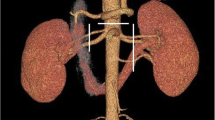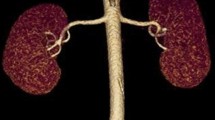Abstract
Purpose
Endovascular navigation in aortic, renal and visceral procedures are based on precise knowledge of arterial anatomy. Our aim was to define the anatomical localization of the ostia of renovisceral arteries and their distribution to establish anatomical landmarks for endovascular catheterization.
Methods
Computer-assisted measurements performed on 55 CT scans and patients features (age, sex, aortic diameter) were analyzed. p values <0.05 were considered statistically significant.
Results
The mean axial angulation of CeT and the SMA origin was 21.8° ± 10.1° and 9.9° ± 10.5°, respectively. The ostia were located on the left anterior edge of the aorta in 96 % of cases for the CeT and 73 % for the SMA. CeT and SMA angles followed Gaussian distribution. Left renal artery (LRA) rose at 96° ± 15° and in 67 % of cases on the left posterior edge. The right renal artery (RRA) rose at −62° ± 16.5° and in 98 % of cases on the right anterior edge of the aorta. RRA angle measurements and cranio-caudal RRA-LRA distance measurements did not follow Gaussian distribution. The mean distances between the CeT and the SMA, LRA, and RRA were 16.7 ± 5.0, 30.7 ± 7.9 and 30.5 ± 7.7 mm, respectively. CeT-SMA distance showed correlation with age and aortic diameter (p = 0.03). CeT-LRA distance showed correlation with age (p = 0.04). The mean distance between the renal ostia was 3.75 ± 0.21 mm. The RRA ostium was higher than the LRA ostium in 52 % of cases. RRA and LRA origins were located at the same level in 7 % of cases.
Conclusion
Our results illustrate aortic elongation with ageing and high anatomical variability of renal arteries. Our findings are complementary to anatomical features previously published and might contribute to enhance endovascular procedures safety and efficacy for vascular surgeons and interventional radiologists.



Similar content being viewed by others
References
Adachi B (1928) Anatomie der Japaner I. Das Arteriensystem der Japaner. Band II. Verlag der Kaiserlich-Japanischen Universität zu Kyoto. Maruzen Publishing Co., Kyoto
Anson BJ, McVay CB (1936) The topographical positions and the mutual relations of the visceral branches of the abdominal aorta. A study of 100 consecutive cadavers. Anat Rec 67(1):7–15
Beregi JP, Mauroy B, Willoteaux S, Mounier-Vehier C, Rémy-Jardin M, Francke J (1998) Anatomic variation in the origin of the main renal arteries: spiral CTA evaluation. Eur Radiol 9(7):1330–1334
Bergman RA, Thomson SA, Afifi AK, Saadeh FA (1988) Compendium of human anatomic variation. Urban & Schwarzenberg, Baltimore, pp 81–82
Cauldwell EW, Anson BJ (1943) The visceral branches of the abdominal aorta: topographical relationships. Am J Anat 73(1):27–57
Cooper CJ, Murphy TP, Cutlip DE, Jamerson K, Henrich W, Reid DM et al (2014) Stenting and medical therapy for atherosclerotic renal-artery stenosis. N Engl J Med 370(1):13–22. doi:10.1056/NEJMoa1310753
Coscas R, Kobeiter H, Desgranges P, Becquemin J-P (2011) Technical aspects, current indications, and results of chimney grafts for juxtarenal aortic aneurysms. J Vasc Surg 53(6):1520–1527. doi:10.1016/j.jvs.2011.01.067
Garcier J-M, De Fraissinette B, Filaire M, Gayard P, Therre T, Ravel A et al (2001) Origin and initial course of the renal arteries a radiological study. Surg Radiol Anat 23(1):51–55
George R (1935) Topography of the unpaired visceral branches of the abdominal aorta. J Anat 69(Pt 2):196–205
Heidsieck E (1928) Zur Skeletopie der grossen Aste der Bauchaorta. Anat Anz 66:6–24
Kamenskiy A, Miserlis D, Adamson P, Adamson M, Knowles T, Neme J et al (2015) Patient demographics and cardiovascular risk factors differentially influence geometric remodeling of the aorta compared with the peripheral arteries. Surgery 158(6):1617–1627. doi:10.1016/j.surg.2015.05.013
Keen EN (1981) Origin of the renal arteries from the aorta. Acta Anat 110:285–286
Kirkwood ML, Guild JB, Arbique GM, Anderson JA, Valentine RJ, Timaran C (2015) Surgeon radiation dose during complex endovascular procedures. J Vasc Surg 62(2):457–463. doi:10.1016/j.jvs.2015.02.050
Mazzaccaro D, Malacrida G, Nano G (2015) Variability of origin of splanchnic and renal vessels from the thoracoabdominal aorta. Eur J Vasc Endovasc Surg 49(1):33–38
Mehran R, Nikolsky E (2006) Contrast-induced nephropathy: definition, epidemiology, and patients at risk. Kidney Int Suppl (100):S11–S5
Ozan H, Alemdaroglu A, Sinav A, Gümüsalan Y (1997) Location of the ostia of the renal arteries in the aorta. Surg Radiol Anat 19:245–247
Ozkan U, Oguzkurt L, Tercan F, Kizilkilic O, Koç Z, Koca N (2006) Renal artery origins and variations: angiographic evaluation of 855 consecutive patients. Diagn Interv Radiol 12(4):183–186
Ozkurt H, Cenker MM, Bas N, Erturk SM, Basak M (2007) Measurement of the distance and angle between the aorta and superior mesenteric artery: normal values in different BMI categories. Surg Radiol Anat 29(7):595–599
Panagouli E, Lolis E, Venieratos DA (2011) Morphometric study concerning the branching points of the main arteries in humans: relationships and correlations. Ann Anat 193(2):86–99. doi:10.1016/j.aanat.2010.10.009
Pennington N, Soames RW (2005) The anterior visceral branches of the abdominal aorta and their relationship to the renal arteries. Surg Radiol Anat 27(5):395–403
Rio Branco P (1912) Essai sur l’anatomie et la médecine opératoire du tronc cœliaque et de l’artère hépatique. G. Steinheil (ed), pp. 65–66
Saltzberg SS, Maldonado TS, Lamparello PJ, Cayne NS, Nalbandian MM, Rosen RJ, Jacobowitz GR, Adelman MA, Gagne PJ, Riles TS, Rockman CB (2005) Is endovascular therapy the preferred treatment for all visceral artery aneurysms? Ann Vasc Surg 19(4):507–515
Saratzis AN, Goodyear S, Sur H, Saedon M, Imray C, Mahmood A (2013) Acute kidney injury after endovascular repair of abdominal aortic aneurysm. J Endovasc Ther 20(3):315–330. doi:10.1583/12-4104MR2.1
Sobocinski Jonathan, d’Utra Guillerme, O’Brien Noel, Midulla Marco, Maurel Blandine, Guillou Matthieu, Azzaoui Richard, Roeder Blayne, Resch Timothy A, Haulon Stéphan (2012) Off-the-shelf fenestrated endografts: a realistic option for more than 70 % of patients with juxtarenal aneurysms. Endovasc Ther 19:165–172. doi:10.1583/11-3772.1
Tacher V, Lin M, Desgranges P, Deux JF, Grünhagen T, Becquemin JP, Luciani A, Rahmouni A, Kobeiter H (2013) Image guidance for endovascular repair of complex aortic aneurysms: comparison of two-dimensional and three-dimensional angiography and image fusion. J Vasc Interv Radiol 24(11):1698–1706. doi:10.1016/j.jvir.2013.07.016
Taniguchi J (1931) Beitrag zur Topographie der grossen Aste der Bauchaorta. Folia Anat Jpn 9:201–214
Tokue H, Tokue A, Tsushima Y (2012) Multidetector-row computed tomography for evaluating the branching angle of the celiac artery: a descriptive study. BMC Med Imaging 21(12):36. doi:10.1186/1471-2342-12-36
Wozniak WT (2000) Origin of the renal arteries from sides of aorta. Folia Morphol (Warsz) 58:259–261
Yahel J, Arensburg B (1998) The topographic relationships of the unpaired visceral branches of the aorta. Clin Anat 11(5):304–309
Yan H (1994) Relationship of the celiac and superior mesenteric arteries to the vertebral bodies and its clinical relevance. Radiat Med 12:105–109
Author information
Authors and Affiliations
Corresponding author
Rights and permissions
About this article
Cite this article
Lawton, J., Touma, J., Sénémaud, J. et al. Computer-assisted study of the axial orientation and distances between renovisceral arteries ostia. Surg Radiol Anat 39, 149–160 (2017). https://doi.org/10.1007/s00276-016-1718-6
Received:
Accepted:
Published:
Issue Date:
DOI: https://doi.org/10.1007/s00276-016-1718-6




